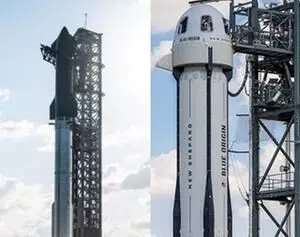
Blue Origin, SpaceX to launch key rockets to space on Sunday
text_fieldsNew Delhi: Billionaire Elon Musk's SpaceX and Amazon founder Jeff Bezos' space firm Blue Origin are slated to launch critical space missions on Sunday. SpaceX will conduct the fifth test launch of the 400-foot-tall Starship rocket and the Heavy booster, the world's largest and most powerful rockets.
Blue Origin, on the other hand, will try again to debut its second human-rated spacecraft, nearly a week after technical issues thwarted its first launch attempt.
“Targeting Sunday, October 13 for Starship’s fifth flight test,” SpaceX said, noting that the launch “will aim to take another step towards full and rapid reusability”.
The company is expected to lift off at 8 a.m. EDT (5:30 pm IST) from its Starbase facility near Boca Chica Beach in South Texas.
With the fifth test flight, SpaceX aims to “attempt the first ever return to the launch site and catch of the Super Heavy booster and another Starship reentry and landing burn, aiming for an on-target splashdown of Starship in the Indian Ocean,” the company said.
This comes after a successful Flight 4 on June 6, which made the first-ever soft-landing of the booster in the Gulf of Mexico and Starship making it a “brilliant reentry”.
Meanwhile, Blue Origin, after calling off the debut of its second human-rated spacecraft on October 7 due to a rocket issue, will make another attempt today.
The launch of the company’s uncrewed NS-27 mission to suborbital space is expected to be at 8:30 a.m. EDT (6.00 pm IST)
The second human-rated New Shepard vehicle consists of a first stage known as Booster 5 and a crew capsule named RSS Karman Line. Karman Line is the internationally recognised boundary of space
While uncrewed, the NS-27 mission will fly 12 research payloads, five of them on the booster and seven inside the capsule. This includes new navigation systems developed for New Shepard and Blue Origin's huge New Glenn rocket, as well as two LIDAR (light detection and ranging) sensors designed to operate in the lunar environment, according to Blue Origin.
With inputs from IANS

















